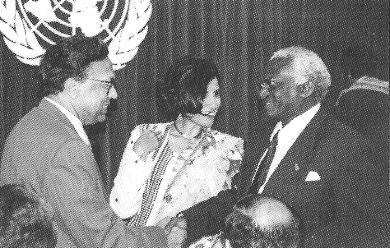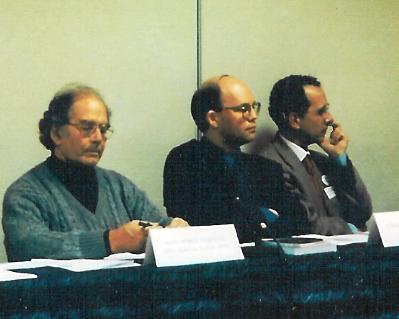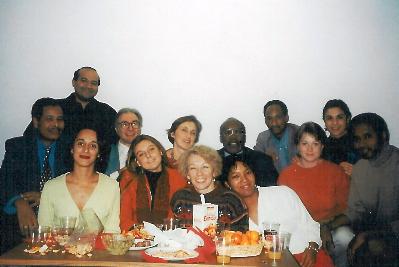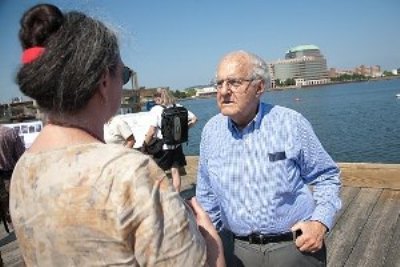Stories
UN Declaration and Programme of Action for a Culture of Peace
Personalities in the "culture of peace bed"
Over the years, the culture of peace attracted a great variety of activists, and in some cases they caused more problems than if they had actually been agents working for the culture of war. I came to see that the culture of peace was a huge "bed," and I could hardly control who got into it with me.
In the following photo are shown two of these crazy personalities, on the right Pierre Marchand and in the center Christian Renoux (On the left is Nobel Peace Laureate Perez Esquivel).
As I have written more extensively in my Early History of the Culture of Peace, the idea for the International Year for the Culture of Peace came from Pierre Marchand, who was the founder and Executive Director of the NGO "Partage avec les Enfants du Monde", based in Compiegne, France, and a member of the International Fellowship of Reconciliation (IFOR), the oldest of the major international pacifist organizations. He wrote to all Nobel Peace Laureates on 28 February 1997, asking them to sign a letter to all Heads of State calling for an International Year of Education for Nonviolence for the Year 2000 and an International Decade for a Culture of Nonviolence from 2000-2010. Learning of this initiative, I went to visit Mr Marchand in April 1997, promised my support and suggested that he seek the support of Director-General Mayor.
Pierre went to New York and visited something like 50 UN ambassadors to lobby for the initiative. As he explained to me, he would look each one in the eye and ask "Do you have any children? What are their names? What kind of world to you want them to grow up in?" Eventually, the initiative came under the responsibility of UNESCO (I arranged and took the minutes for many meetings between Pierre and Director-General Mayor), but in the beginning, singlehandedly, Pierre put the initiative on the UN agenda.
But then began a crazy sequence of events. Christian Renoux, a member of Partage and of IFOR, for reasons I have never fully understood, brought charges against Marchand for embezzlement of funds from Partage, which eventually led to his imprisonment. Meanwhile, at IFOR, Renoux was centrally involved in a fight against the naming of a new President (if I recall correctly from Africa and not a Roman Catholic), which he "won" in the sense that the appointment was blocked and the entire staff was decimated. My good friend, the Secretary, was dismissed, and there was one suicide and one person who committed hereself to a mental hospital. As my friend explained, she wants visited Renoux at home and found in the entry-way a huge painting of San Sebastian with the arrows piercing his body. A good Catholic!
Eventually, Pierre disappeared from sight after a bizarre set of incidents in South Asia where it was said he lost all his memory (I never knew if the stories were true), and Renoux went on to found his own organization for the International Culture of Peace Decade which refused to cooperate with the World Report that we were writing.
I have mentioned Director-General Federico Mayor above. He, too, was a crazy personality, but he deserves more space, so I have devoted another page for him.
Among Mayor's bad habits as Director-General was to give the same task to more than one unit and let them "fight it out" for funding, etc. We referred to it as his habit of "playing god." At one point he hired a new, high-level staff member for our unit, Ingeborg Breines and gave her responsibility for "culture of peace for women." The problem was that there was already a unit in the Social Science sector, headed by an Algerian woman for "culture of peace for women." Ingeborg is shown (center, back row) in the following photo of our unit from 1997, between me and Leslie Atherley, who the director at that point.
Ingeborg did not want to work with me on the issues of culture of peace and women's equality (she was in charge of our involvement in the UN Beijing Conference), as her issue was simply changing the way that boys are brought up so that they would not be "macho." This was not a problem until Leslie retired as director, and she claimed that she should be the new director. Despite the orders from the Director-General that the office and facilities should be under my direction, she "occupied" the office for almost a year, refusing to leave, and I was left to fend for myself. Needless to say our relations were not good after that. After Mayor left as Director-General, it made little difference because the whole program was essentially abandoned.
Another problematic personality was Anwarul Chowdhury. When he was ambassador from Bangladesh, Anwarul played the key role in the UN to get the Declaration and Program of Action for a Culture of Peace adopted by the General Assembly, in spite of persist opposition from all the rich member states. Later, under Secretary-General Kofi Annan, he became an under secretary-general at the UN as representative of the small member states, and continued to work for the culture of peace and for Resolution 1325 for women in peacekeeping, which he had introduced earlier to the UN Security Council. Here is a photo of him at the time he was advocating for the Declaration and Program of Action. He is on left with Nobel Peace Laureate Desmond Tutu on the right and the director of the UNESCO office in New York, Nina Sibal, in the center. Nina was quite ill with a brain tumor at that time, and very, very difficult to deal with. But let me stay here with Chowdhury.
 .
.
For more than a decade, Chowdhury and I had only the best of relations. I used to take young people to see him when he was under secretary-general and he was very inspiring to them. And he wrote an excellent introduction to our 2010 World Report on the Culture of Peace. But something happened in 2011. Was it related to the brain tumor which he had barely survived in 2009-2010? Or, more likely, was it related to his close partnership with the Japanese Buddhist sect, Soka Gakkai? Probably just the latter (he was financially supported by Soka Gakkai as a professor in their California university). In any case, Chowdhury helped organize a group of NGO representatives at the UN to continue the work of culture of peace after the end of the Decade, and he became very manipulative and ego-centric. The group contacted a number of the NGO's listed in the World Report, asking them to be representatives in a new organization to be named "Global Movement for a Culture of Peace." I objected that by their very nature, social movements cannot have an organization at the head, and so the title was inappropriate. At that point he became very insistent, even manipulative, and it seemed that his goal was to purge the little group of all who would not follow the orders of himself and Soka Gakkai. At the same time, he claimed that the inclusion of paragraphs in the annual UN culture of peace resolution that made reference to the "programme of action for a culture of peace" adopted at the 2011 UNESCO General Conference, was as a form of "sabotage." Sabotage of what? I decided not to press the issue.
Since I had decided that it was strategically important to establish culture of peace at the level of the city, I tried to work with the New Haven Peace Commission in 2009, but Marder was quite negative when I presented my ideas to the Commission. He was clearly afraid I would usurp some of his power. Afterwards, Joelle Fishman, our old Communist party comrade and a member of the Commission, took me aside and said "I don't want to mediate a fight between you two." I replied, "Don't worrry, I don't need such a fight. I won't come back to the Commission as long as Al is heading it up."
Writing this epilogue in 2013, I note that I am back on good relations with Mr Mayor who wants me to represent his Foundation in the US, and with Al Marder, with whom I have a better working relationship now that I have joined the New Haven Peace Commission. With Chowdhury, however, things seem to be going from bad to worse. Let's see what happens!
 |
Stages
1986-1992
Fall of Soviet Empire
1992-1997
UNESCO Culture of Peace Programme


